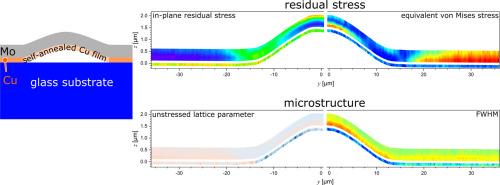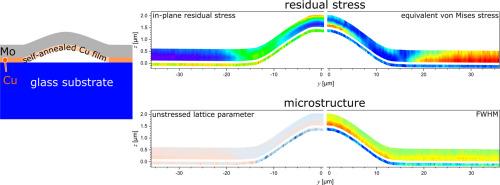Nanoscale stress and microstructure gradients across a buckled Mo-Cu bilayer: Cu self-annealing triggered by interface delamination
IF 8.3
1区 材料科学
Q1 MATERIALS SCIENCE, MULTIDISCIPLINARY
引用次数: 0
Abstract
Residual stresses in thin film structures significantly impact their mechanical properties and affect interface delamination. Highly compressively stressed thin films buckling is the predominant interfacial failure mode due to strain energy release. In the present study the effect of cross-sectional stress and microstructural gradients of thin films on the buckling behavior are explored in a model material system consisting of a thin Cu film sputtered onto glass and a highly compressively stressed 500 nm thick Mo overlayer causing buckling delamination at the Cu-glass interface. Employing synchrotron cross-sectional X-ray nano-diffraction, multiaxial X-ray elastic strain and microstructure distributions were explored across the cross-section of the adhering and buckled bilayer, respectively. In the adhering state, a gradual thickness evolution of columnar microstructure and residual stress was found for Mo, while in Cu, no microstructure changes and only minimal stress variations were detected along the film thickness. After delamination, diffraction peak broadening and changes in unstrained lattice parameters in the Cu sublayer indicated structural defect annihilation and grain coarsening. These microstructural changes were further validated via cross-sectional transmission electron microscopy. The evaluated residual stress distributions across the two sublayers of the pristine and buckled bilayer were used to quantify the released strain energy per unit area due to buckling, amounting to 0.61 J/m². Further cross-validation of experimental stress results with finite element simulations strengthened the experimental findings, providing a comprehensive understanding of the stress distribution across the buckled bilayer.


弯曲钼铜双分子层上的纳米级应力和微观结构梯度:由界面分层引发的铜自退火
薄膜结构中的残余应力会严重影响其机械性能,并影响界面分层。由于应变能的释放,高压缩应力薄膜屈曲是最主要的界面破坏模式。本研究探讨了薄膜的横截面应力和微观结构梯度对屈曲行为的影响,该模型材料系统由溅射到玻璃上的铜薄膜和在铜-玻璃界面上造成屈曲分层的高压缩应力 500 nm 厚的钼覆盖层组成。利用同步辐射横截面 X 射线纳米衍射技术,分别对粘附和屈曲双层材料横截面上的多轴 X 射线弹性应变和微观结构分布进行了研究。在粘附状态下,发现钼的柱状微观结构和残余应力在厚度上逐渐演变,而铜的微观结构没有变化,沿薄膜厚度只检测到极小的应力变化。分层后,铜亚层中衍射峰的扩大和非应变晶格参数的变化表明结构缺陷湮灭和晶粒粗化。横截面透射电子显微镜进一步验证了这些微观结构变化。原始双层和屈曲双层两个子层的残余应力分布评估结果被用来量化屈曲导致的单位面积释放应变能,达到 0.61 J/m²。实验应力结果与有限元模拟结果的进一步交叉验证加强了实验结果,为全面了解屈曲双分子层的应力分布提供了依据。
本文章由计算机程序翻译,如有差异,请以英文原文为准。
求助全文
约1分钟内获得全文
求助全文
来源期刊

Acta Materialia
工程技术-材料科学:综合
CiteScore
16.10
自引率
8.50%
发文量
801
审稿时长
53 days
期刊介绍:
Acta Materialia serves as a platform for publishing full-length, original papers and commissioned overviews that contribute to a profound understanding of the correlation between the processing, structure, and properties of inorganic materials. The journal seeks papers with high impact potential or those that significantly propel the field forward. The scope includes the atomic and molecular arrangements, chemical and electronic structures, and microstructure of materials, focusing on their mechanical or functional behavior across all length scales, including nanostructures.
 求助内容:
求助内容: 应助结果提醒方式:
应助结果提醒方式:


